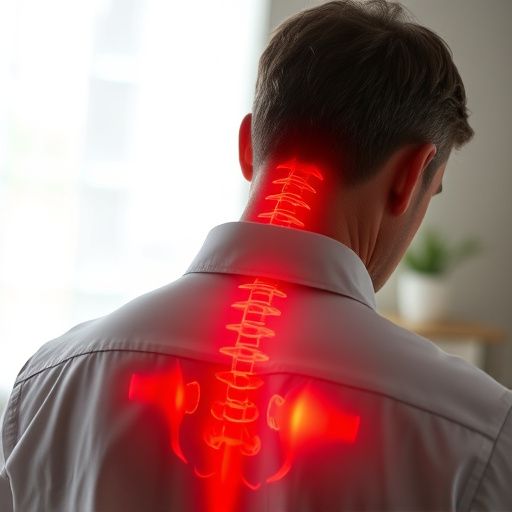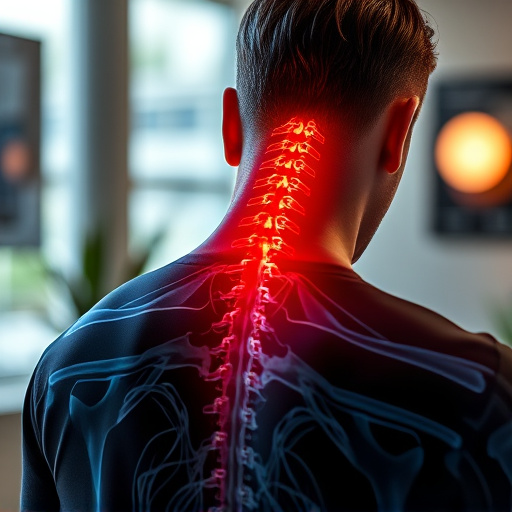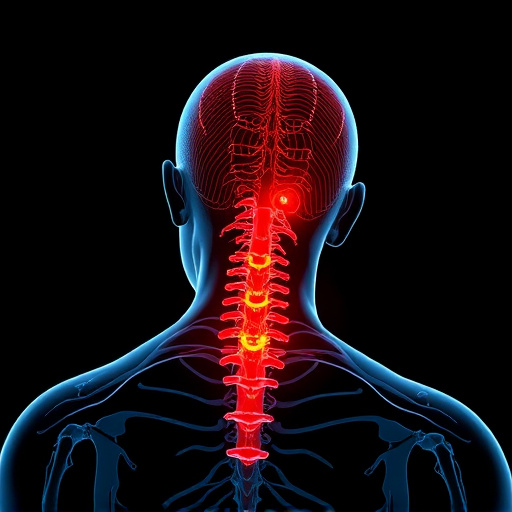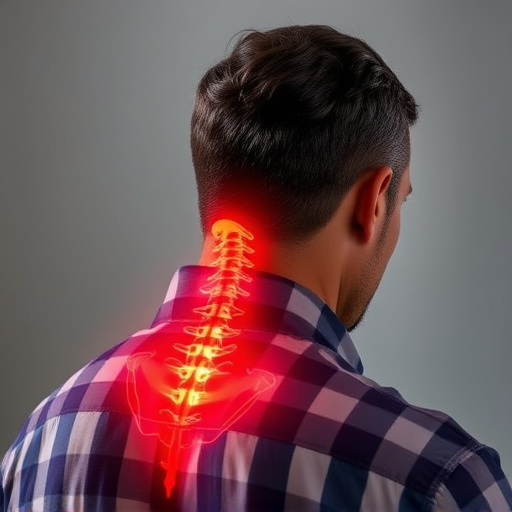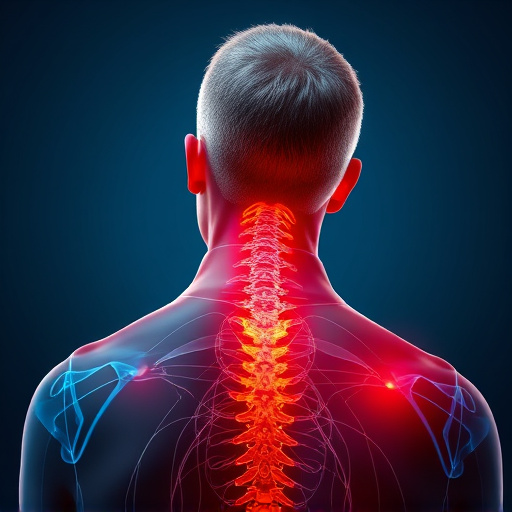Cervical spine disorders cause pain and stiffness in the neck and upper back, impacting daily life with common causes including muscular tension from repetitive movements or poor posture, and age-related degenerative changes. Workers' Compensation offers a comprehensive framework for addressing workplace injuries, integrating treatments like physical therapy, medication, and surgery to alleviate pressure on nerves and restore mobility. Non-invasive options include chiropractic care and physical therapy, providing immediate comfort and aiding in healing. Maintaining good posture through regular breaks, ergonomic adjustments, exercise, and healthy weight is crucial for preventing recurring pain and stiffness post-workers' compensation injury care.
Experiencing pain and stiffness in your cervical area? You’re not alone. Cervical pain, often linked to workplace injuries covered under workers’ compensation, demands tailored care. This comprehensive guide delves into the causes, risk factors, and a multi-faceted approach to relief. From non-invasive treatments and physical therapy to medications and alternative therapies, we explore options for symptom management. Learn preventive measures to avoid recurrence and navigate workers’ compensation injury care effectively.
- Understanding Cervical Pain and Stiffness: Causes and Risk Factors
- Workers' Compensation and Cervical Injury Care: A Comprehensive Approach
- Non-Invasive Treatment Options for Relief
- Role of Physical Therapy in Managing Symptoms
- Exploring Medication and Alternative Therapies
- Preventive Measures to Avoid Recurrence
Understanding Cervical Pain and Stiffness: Causes and Risk Factors

Cervical pain and stiffness, often experienced in the neck and upper back, can significantly impact daily activities and overall quality of life. This condition, commonly known as cervical spine disorder, is not always a result of an injury or accident; it can also develop over time due to various risk factors. One significant aspect to consider when dealing with cervical pain is understanding its underlying causes, which can be attributed to different scenarios.
One common cause is muscular tension and strain, often associated with repetitive movements or poor posture, especially in individuals who work long hours at desks or perform manual labor. Additionally, age-related wear and tear, known as degenerative changes, can lead to cervical stiffness and pain. Workers compensation injury care plays a crucial role in addressing these issues, offering treatments such as physical therapy, medication, and, in severe cases, surgical intervention to relieve pressure on the nerves and restore mobility.
Workers' Compensation and Cervical Injury Care: A Comprehensive Approach

Many workplace injuries, especially those involving repetitive motions or sudden traumas, fall under Workers’ Compensation, providing a structured framework for medical care and financial support. When it comes to cervical area pain and stiffness, this system ensures employees receive comprehensive workers compensation injury care. This includes access to specialized healthcare professionals who can offer tailored solutions, from physical therapy to advanced medical interventions.
A key aspect of this approach is the integration of various treatment modalities. Healthcare providers focus on not just alleviating symptoms but also on preventing long-term disabilities and promoting a full recovery. By adhering to evidence-based practices and individualized care plans, workers can effectively manage their cervical injuries, regain mobility, and return to their jobs safely and efficiently.
Non-Invasive Treatment Options for Relief

Many individuals suffering from pain and stiffness in the cervical area, often related to workers’ compensation injuries, are seeking non-invasive treatment options for effective relief. Thankfully, there are several gentle and safe approaches that can significantly improve mobility and reduce discomfort. One popular method is chiropractic care, which involves manual adjustments to the spine to alleviate pressure on nerves and restore range of motion. This conservative treatment has shown promise in reducing cervical pain and improving overall neck health.
Additionally, physical therapy plays a crucial role in non-invasive care. Trained therapists design customized exercise programs to strengthen muscles supporting the cervical spine, improve posture, and increase flexibility. These exercises can be particularly beneficial for workers compensation injury victims as they aid in the healing process, promote better body mechanics, and help prevent future injuries.
Role of Physical Therapy in Managing Symptoms

Physical therapy plays a pivotal role in managing symptoms associated with cervical pain and stiffness, especially in cases involving workers’ compensation injuries. Specialized therapists employ a range of techniques tailored to alleviate discomfort and restore mobility in the neck region. These include manual therapy, such as joint mobilization and soft tissue manipulation, which help reduce muscle tension and improve spinal alignment.
The therapeutic approach often incorporates exercises designed to strengthen the cervical muscles and enhance flexibility. This proactive care not only provides immediate relief but also empowers individuals to manage their condition effectively. By addressing the root causes of pain and stiffness, physical therapy becomes a valuable component in the long-term treatment plan for workers’ compensation injury cases, contributing to faster recovery and improved overall function.
Exploring Medication and Alternative Therapies

When it comes to alleviating pain and stiffness in the cervical area, especially following a work-related injury covered under workers’ compensation, there are various options available beyond traditional medical treatments. Many individuals find relief through alternative therapies that cater specifically to managing chronic pain. These include techniques such as chiropractic care, which focuses on adjusting the spine to reduce pressure on nerves, and physical therapy, designed to improve flexibility and strengthen muscles supporting the neck.
Additionally, medication plays a significant role in managing symptoms. Over-the-counter pain relievers like ibuprofen or acetaminophen can provide temporary relief from discomfort. For more severe cases, doctors may prescribe stronger medications to manage pain and reduce inflammation. It’s essential to consult with healthcare professionals to determine the best course of action, especially when considering workers’ compensation injury care, as they can guide individuals toward safe and effective options tailored to their unique needs.
Preventive Measures to Avoid Recurrence

To prevent the recurrence of pain and stiffness in the cervical area, especially post-workers’ compensation injury care, maintaining a good posture is paramount. Prolonged periods of sitting or bending over can exacerbate existing issues and lead to further discomfort. Therefore, regular breaks during work are essential, encouraging movement and stretching. Simple ergonomic adjustments at the workplace, such as using an adjustable desk or supporting equipment like wrist rests, can also significantly reduce strain on the neck and shoulders.
Additionally, engaging in regular physical activity tailored to strengthen the neck and back muscles is beneficial. Yoga, for instance, promotes flexibility and core strength, helping to prevent future injuries. Maintaining a healthy weight is another crucial aspect, as excess weight puts additional pressure on the cervical spine. Incorporating these preventive measures into daily routines can greatly contribute to long-term relief and well-being.






